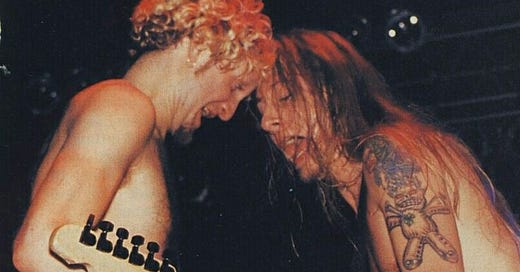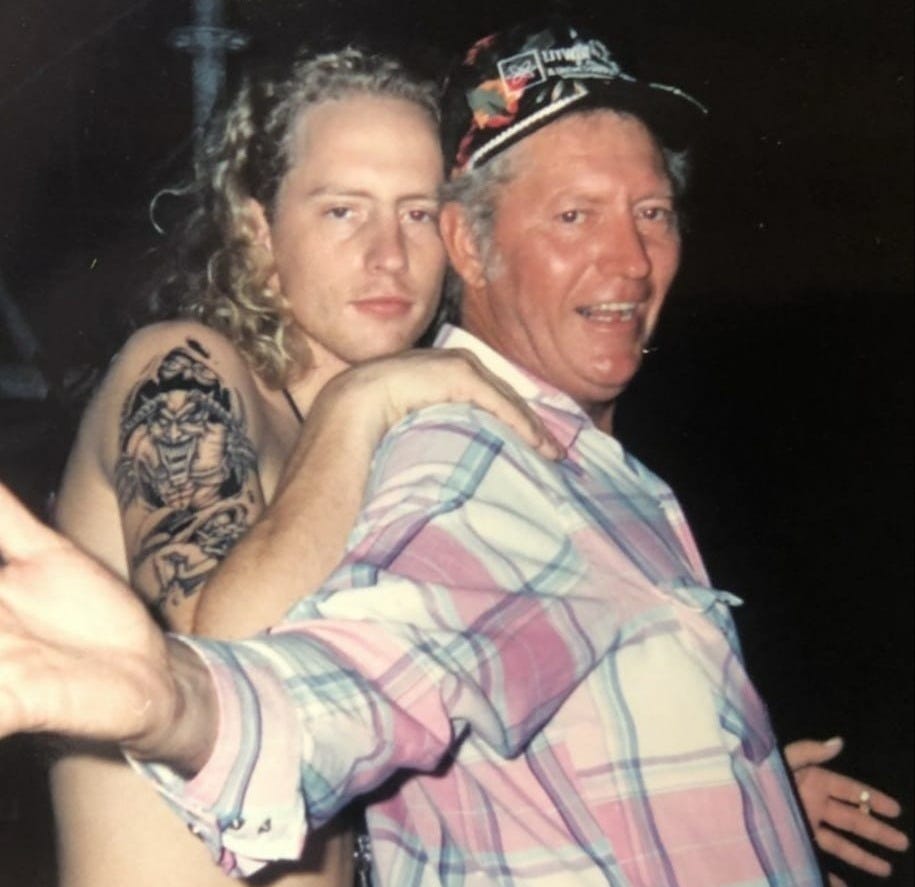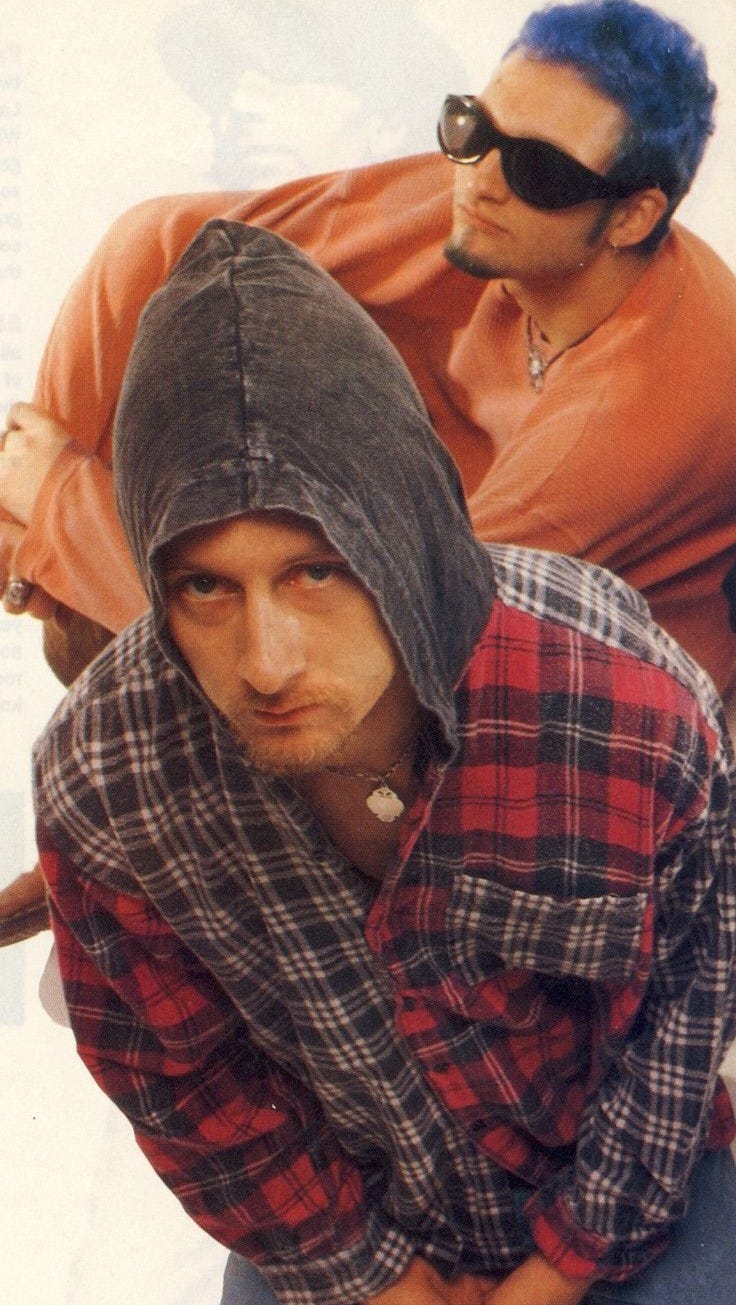Jerry Cantrell: the man behind 'man in the box'
The Seattle grunge scene was at its peak in the early 90s.
Alice In Chains guitarist Jerry Cantrell was born in Tacoma Washington to parents Jerry Cantrell Sr. and Gloria Jean Cantrell. He grew up with his younger brother David, who was the inspiration for the band’s song Brother featured on their 1992 EP Sap. In high school, Jerry became involved in theater, participating in school plays and singing in choir. Growing up, he’d always been interested in music and begged his parents for an electric guitar. When he was a teen, his father bought him an acoustic guitar instead, causing Jerry to be disappointed. He hated it and never really picked it up. A couple of years later, he bought an electric guitar with his own money— his first real guitar, he described it— while working at a music store.
Jerry attended college for a short time before he decided he really wanted to pursue music. He left class during the middle of an exam and never looked back. He moved to Dallas and then later Houston. In the summer of ‘87, Jerry met Layne Staley at a party in Seattle. At the time, the band was called Alice ‘N Chains and Layne’s vocal range impressed Jerry, making him want to work with him. Soon after, the two became roommates.
Sadly, Jerry’s mother passed away that same year from pancreatic cancer when Jerry was just 21, causing him to fall into depression. His grandmother had just died in late ‘86, so losing two people closest to him in the span of a couple of months took a toll on him.
Alice In Chains’ first record was titled Facelift and released in 1990. Jerry wasn’t just the band’s guitarist, he also wrote songs with Layne and was the backup vocals. Compared to Layne’s powerful belts, Jerry’s voice is softer, creating a balanced a capella. The two became close friends instantly and Jerry has even praised Layne’s generosity; upon meeting, Layne was already offering Jerry a place to sleep.
The first song on the record is titled We Die Young, which was written by Jerry while on a bus ride to a band rehearsal. He had witnessed two very young boys dealing drugs, and was hit with the terrible epiphany that the younger generation are starting to die young due to their early involvement with crime. Though the lyrics are dark, the riff is very catchy— this is a recurring beautiful gift of Jerry’s, to create melodic riffs that stick. The 90s had just started, so there was still that 80s rock influence. Layne’s curls were still wild and twisted into dreads which he shook on stage, like a lion’s wild mane. But their most popular song on that album is Man In The Box, which launched them into mainstream fame. The track is a metaphor for unreliability and censorship shown in the mass media. Layne stated he was stoned when he wrote it.
1992’s Dirt was their second album and just as well received. It opens with a punchy Them Bones. Jerry said about the song, “I was just thinking about mortality, that one of these days we’ll end up a pile of bones. It’s a thought for every human being, whether you believe in an after-life or that when we die, that’s it.” There’s a heavier feel to this album— though not as much as their self-titled— with talks of depression and death. Their song Would? which is the last track on the record is a tribute to Andrew Wood, a close friend of theirs and singer of the band Mother Love Bone who passed from a heroin overdose. The song first appeared on the soundtrack from the movie Singles, which Alice In Chains made a cameo in, as well as other Seattle grunge bands of the time such as Pearl Jam, Soundgarden, and Mudhoney.
Down in a Hole speaks about drug addiction, which Layne suffered from throughout his career and led to his passing. Though, Jerry has also said that he wrote this song for his then girlfriend of seven years Courtney Clarke. She is briefly seen in one of the band’s ‘Nona’ tapes, in which Jerry does a bit where he is dressed as an Italian grandmother and interviews the band. Given his theater background, Jerry is notorious for his comical bits.
Jerry and Courtney supposedly met at a Guns N’ Roses concert in the late 80s and she soon became his muse for other songs like Rain When I Die. Though, the two broke it off in ‘97 due to Jerry’s constant infidelity. Jerry shows off his guitar skills in Rain When I Die, giving the track a one minute funky intro before Layne’s vocals begin. The guitar is so satisfying here, giving the song a ‘wonky’ sound like aluminum foil being wobbled (in a good way). Layne’s vocals are also as impressive as he belts the repetitive chorus. Though the track is a bit drawn out, ending at six minutes, its consistent sound makes it a catchy hit.
Their song Rooster also gained popularity, which Jerry wrote for his father. When his father fought in the Vietnam war, he gained the nickname ‘rooster’ for his cocky attitude and the way his hair used to stick up like a rooster. In military terms, rooster refers to the nickname for the M60 machine gunner, giving the song a layered meaning.
In 1993, the band released their melodic single What the Hell Have I which can be heard during one of my favorite interviews conducted by Riki Rachtam aired on Headbangers Ball. It was a television program that aired in the late 80s until 2012 on MTV, which aired heavy metal music videos. The band has been previously interviewed by Riki, but in this particular interview, the band visit the Action Water Park in New Jersey. Jerry is sporting a blue speedo and some snorkeling goggles. At this point, the band’s bassist Mike Starr had left the band due to his drug abuse and was replaced by Mike Inez. Mike (Inez) is known for his connections to Ozzy Osbourne and other bands.
Layne’s drug addiction had also worsened here, which inspired their next EP Jar of Flies in 1994. The album cover shows a child staring at a jar of underfed, trapped flies which Jerry stated was a symbolism of overindulgence and its consequences. The songs explore themes of isolation, depression, and addiction which the band was going through at the time, especially their front man Layne. Though much of their songs is about addiction, the band has stated that they’re more cautionary than encouraging to their fans. The EP was received well by fans despite their change in sound. Compared to their previous album’s head-banging heavy sound, this EP has a more melodic tone yet still grunge-y. The entire EP feels like seasonal depression and autumn.
Nutshell, one of their most popular songs, centers around Layne’s drug addiction. There’s a heaviness to it that makes you feel his dark headspace and isolation. He says he’s fighting “a battle all alone” and has “no one to cry to” or a “place to call home.” The lyrics are self-explanatory, offering a raw story about the depression that comes with addiction.
Their song No Excuses is also about Layne’s struggles and was one of the songs performed during MTV’s Unplugged in ’96. That same year, Layne’s girlfriend Demri Parott had died from a drug overdose. It’s believed that his inability to cope with her passing led to his ultimate overdose in 2002. During the MTV Unplugged performance, Layne’s hair is shorter and dyed a hot pink. He looks a bit out of it and even momentarily forgets the lyrics to Sludge Factory, a song from their 1995 self-titled album. The band remains patient, though, especially Jerry who’s nonchalantly smoking a cigarette as he plays acoustic. He nods at Layne, with a faint, patient smile. But despite looking tired, Layne’s vocals remain strong and this would become one of Alice In Chains’ most memorable performances.
Apart from the heavy-hitting songs, their Jar of Flies EP was the band’s opportunity to experiment with their sound like their two minute instrumental Whale & Wasp and their funky track Swing on This.
The band switches to a more heavier, sludgy sound in their 1995 self-titled album. With the rise of alternative rock and nu metal in the late 90s, grunge was beginning to die out. Jerry’s vocals are more prominent in this album, especially in Heaven Beside You where Layne does the backup vocals instead. Jerry has stated before that he’s never been as confident with his vocals but Layne had always encouraged him to sing more.
Layne’s voice is present in Sludge Factory, yet more muted than his usual belts. Both Layne and Jerry’s harmonic vocals are high-pitched over the muddy heaviness of the guitar. Here, they criticize their label for rushing them to complete the album. The label is a ‘sludge factory,’ pumping out meaningless music from artists for profit. Much like the song’s title, the song feels just like that— sludge. The vocals are drawn out and the music feels depressingly heavy. Frogs and God Am feel equally heavy. God Am is about Layne’s frustration with God and His inability to pull Layne out of his drug addiction. The album cover is a neon green, grimy color featuring a three-legged dog that references drummer Sean Kinney’s childhood experience of being chased by a three-legged dog. The image encapsulates the overall gritty feel the album evokes.
This was supposed to be Alice In Chains’ last album, and that’s clear by the last track Over Now. This track truly feels like the end of something big and it fills the listener with dread. The guitar is somber towards the end, like the end credits of a very heartfelt film.
After this, Jerry went on to have a minor solo career, releasing Boggy Depot in ‘98 and Degradation Trip in 2002. Jerry’s song Angel Eyes was allegedly about his ex Courtney, and his single She Was My Girl was featured on the 2002 Spiderman soundtrack. His album released a couple of months after Layne’s death. After a show, Jerry took a six AM plane to Washington to attend Layne’s funeral. A week later, he paid tribute to his friend at a concert he dedicated to him.
Alice In Chains made their return in 2009 with new vocalist William DuVall. Jerry continued releasing his own solo works. Recently, he worked on the Sinners soundtrack, collaborating with Ludwig Goransson to create In Moonlight.






